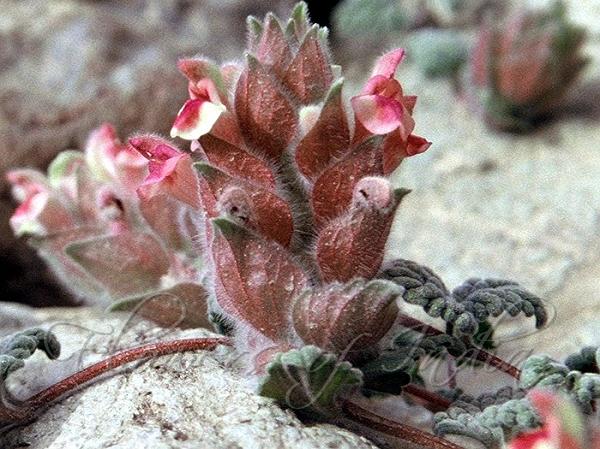|
| Hairy-Bract Skullcap |
|

|

|
|
|
|
Photo: |
Botanical name: Scutellaria heydei Family: Lamiaceae (Mint family)
Hairy-Bract Skullcap is a distinctive high alpine plant
growing up to, and over, 4000 m; characteristic features are its
scree-like habit, the condensed inflorescences, the long fringed with
hairs, hairy bracts and the membranous-inflated scutellum in fruit.
Hairy-Bract Skullcap is named in honour of Enrique Teophila Heyde,
Guatemalan cleric and plant collector.
It is a perennial prostrate woody herb with a woody rootstock. Stems
are 5-30 cm, the longer ones rooting at intervals, prostrate, slender,
round-four-edged, leafy, much branched. Leaves are 6-14 x 6-11 mm,
ovate to broadly ovate, hairy, regularly rounded toothed, wedge-shaped,
pointed or blunt, carried on leaf-stalks 2-11 mm. Inflorescence is
4-sided, condensed, abbreviated, at branch-ends or lateral. Flowers are
subtended by elliptic to broadly elliptic, 6-13 x 3-6 mm bracts which
are entire, wedge-shaped, pointed, purple or green, thin-textured,
overlapping, hoodlike and densely glandular-hairy. Flower-stalks are
2.5-5 mm, erect, flattened. Sepal-cup is 1.5-2 mm, enlarging in fruit
to 4 mm. Flowers are 2.3-3.1 cm, yellow to purplish, spreading-erect or
erect, externally glandular- and eglandular-hairy; tube 1.8-2.5 cm.
Hairy-Bract Skullcap is found in high Himalaya, from Afghanistan, Pakistan
to Tibet, West Himalaya, at altitudes of 2700-4000 m. Flowering:
June-July.
| Identification credit: Yves Lemennicier | Photographed in Zanskar, Ladakh. |
• Is this flower misidentified? If yes,